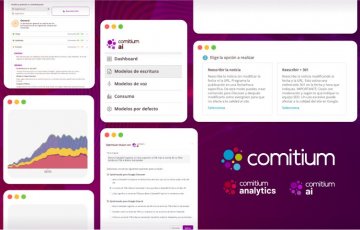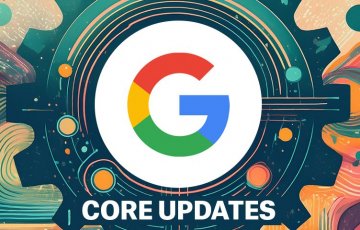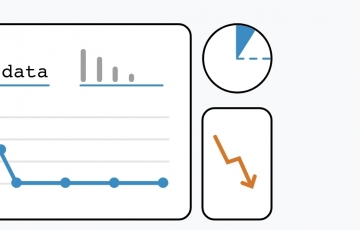Web analytics (II)
Qualitative metrics in Google Analytics

Hello! What's going on?
Here we are again, eager to continue writing about the technological topics we are most passionate about.
But first of all, I would like to thank all of you who have contacted us via e-mail or phone, to encourage us to continue writing in the wearebab blog.
After the first post Web Analítica in which I defined some basic concepts to introduce you to the world of Google Analytics, now I propose you to move forward with the analysis of some qualitative metrics taken into little consideration, but of great importance for your project.
I fully understand the importance that is given today to the volume of unique users, the number of visits and at another level, the page views and as you know, great efforts of all kinds (economic, analytical, strategic ...) are made to try to improve and increase these figures.
But notice that we usually talk about quantity, but rarely about quality. This post aims precisely to give relevance to qualitative metrics.
What are the main quantity indicators in Google Analytics?
- Unique users
- Visits
- Page views
And what are the main quality indicators in Google Analytics?
- Page views / session
- Bounce rate
- Duration of visit
- New vs. returning users
You can increase quantity indicators in several ways. For example, buying traffic via advertising campaigns on Google, via social networks such as Facebook, Twitter, LinkedIn, or by creating creative and ingenious strategies on marketplaces, comparison sites, information portals...
You can also create new types of content that bring new audiences and therefore increase the volume of your project's quantitative indicators. The possibilities to increase volume are many and diverse, but regardless of the return you can get with these investments, what you will surely increase is the quantity.
But as I said ... What about quality? This is much more complex, because you can buy traffic and generate more unique users, visits and/or page views but .... how can you improve your qualitative metrics?

Qualitative metrics indicate how users consume your content, how they interact with it and what interest they show in the digital media in question. In short, they indicate the level of loyalty of your audience and what level of relevance you have in the market.
I would not want to fail to comment on the importance that advertising agencies, purchasing centers and advertisers are now giving to these metrics, which are beginning to reward the media, not only for their quantitative indicators, but also for their qualitative ones.
We analyze some of these metrics and their indicators.
What does 1.25% page views/visit tell us?
Well, it indicates that we have a metric that can be improved.
It shows that each visit that a user makes only sees 1 page and a quarter, that is to say, that we do not get that on average users consult 2 contents. If we continue stretching the ball, if we do not get them to generate two page views implies that a large part of users only see 1 single content and therefore, sure that the bounce rate will be very high, close to 80% or 90%. Then the duration of the visit will happen the same! So unfortunately you will have a visit duration of 40 seconds.
And what does a bounce rate of 85% tell us?
Again, this is a metric that invites reflection. This figure indicates that 85% of the traffic that comes to your project only consumes 1 single piece of content that interests them occasionally, but then they leave. The reading that the market makes is harsh and unfortunately very logical. It is as simple as that 85% of the traffic that comes to your project is not interested in the content and shows it by entering and leaving, i.e. bounces, as if it hit a wall. In addition, let's keep in mind that the duration of users who only make one interaction on your website, implies that the duration of the visit computes 0 in Google Analytics, even though it may be 3 minutes reading a content. We will explain in a future post how to solve this problem.
What if we are talking about 40 seconds of visit duration?
It implies that users do not read the content carefully and therefore, we will have a high bounce rate, since they generate only one page view per visit and the page views/visit metric will be very close to 1.
As you have been able to see, I am presenting you with a rather catastrophic scenario, but as a practical example it is useful to show that these qualitative metrics are all linked. If one improves, they all improve. If one gets worse... they all get worse.
I would like to relativize the previous explanation with certain nuances. The behavior of a digital newspaper is not the same as that of an e-commerce and a corporate website is not the same as an institutional portal. In each project the meaning of the metrics and the analysis to be performed is a specific exercise and must be properly contextualized. The most obvious example is the digital newspapers that are the most punished with these qualitative metrics... but why? Quite simply, because of the behavior of the audience with social networks and mobile technology.
How does today's society consume information?
With the cell phone and on the timelines or walls of social networks. The way to interact is very simple and we all do it every day. We consult our walls and scroll down vertically until we find some information that we find interesting or that simply catches our attention. At that moment we access the media in question and after consuming the content we return to our timeline. What causes this behavior? Unfortunately, it plummets all qualitative metrics since it generates bounces, low time of visit and only 1 page view. It's a total disaster.

How can we improve qualitative metrics?
There are multiple strategies to improve these metrics and for each project the what and how should be analyzed, but I would like to point out some relevant aspects to review, ordered by importance:
1. Quality of content
Yes, okay, I can imagine what you're thinking... that the smart guy of the class has arrived... ?
The solution to all problems in the field of analytics, business, advertising, sales... is to have a project with services or contents of the highest quality, which are different from the competition, witty, creative and brilliant... It is very easy to say, and very difficult to do, but honestly, if at this point you are one of the best in your environment, the rest will come by itself.
2. Speed
The download speed of the content is essential for the user to make more clicks per page and have the opportunity to go click by click into your project. If he has to wait 5 seconds each time... unfortunately he will leave. This is the normal behavior, therefore, you must give the download of your content all the importance it deserves from the Apps whether they are native, hybrid or Progressive Web Apps .
3. Recirculation
The objective of recirculation is that when the audience lands on your media, they consume one content, and then another and so on repeatedly. To achieve this, related contents are very important, as well as the most relevant daily contents, therefore, a good categorization and a proper relationship between them is essential to make internal navigation more effective.
4. Usability and design
It is also very important. The pleasure of browsing a well-developed web page, well thought out, with a usability that does not make me think and with a modern and pleasant design, manages to generate an optimal user experience, which converts the users who visit you into loyal and therefore recurrent users that increase the qualitative metrics of your project.
So much for the second technological pill of Web Analytics. And if thanks to this post you spend 10 minutes thinking about the qualitative metrics of your project, I will have achieved my goal. Fantastic!
If your publishing project needs a strategy to improve qualitative metrics, do not hesitate to contact us and we will find a solution tailored to your needs.
In the next post we will talk about the origin of CMS or content management systems, how they have evolved until today and which one is the best for your publishing project on the Internet.
If you liked the content, you can share this post on social networks and 1 like will also encourage us to continue... it's free and you know that the best things in life always are.... ?
If you want to suggest a topic that adds value to the day to day of your editorial project you can do it here and if you want to subscribe to our newsletter, just leave a name and an email in the field below, and you will receive the news of our blog before anyone else.
We'll continue talking about what we like the most. Will you be there?
See you soon!
And finally, did you know...
There are online services that show heat maps, click maps, videos with the behavior of users browsing your website, etc... so that you can make decisions to evolve and improve your project objectively thanks to empirical data. Avoid deciding based on the opinions of those around you and look for proven data that show the way to improve.




